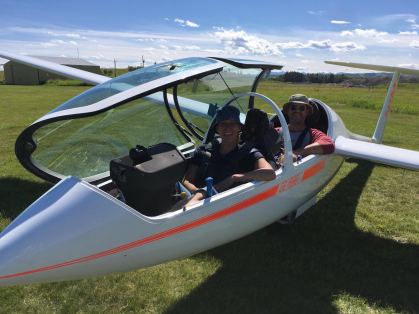Experiences
Over the Hills and Far Away
I’m in a DG-1000S, outside of gliding range to the home field for the first time, I’m getting low, but I’m with the club CFI and XC virtuoso Chris Gough. All of my brainpower is consumed to make decisions based on very little experience in this situation, but I’m working through the issues and figuring it out with expert guidance.
Rewind 3 months. The world has entered a pandemic, where public health guidelines say that we should physically distance from others, outdoor gatherings are acceptable, and UV more than likely kills the virus on surfaces quickly. I turn to the woman who married me, an experienced glider pilot, and we say “Let’s rope our gliding friends in Okotoks into joining the Cu Nim Gliding Club and we can all hang out together responsibly!”
I climbed up through the Canadian Air Cadet Gliding Program, but I have also flown at numerous soaring clubs in Ontario and at Edmonton Soaring Club in Alberta, albeit as a Tow Pilot mainly. I’ve flown a few nice hour-long trips around the patch, but I never had the knowledge or experience to spread my wings and try some of the things I’ve read about for decades in Free Flight.
We enter Cu Nim as a family, and instantly feel connected to the geography and the people – what a feeling! Underlying the inescapable positivity towards our membership is something else that I can’t put my finger on initially. As the first few weeks lead to check-outs and transitions to single-seat performers, we notice an unmistakable “XC culture” bubbling below the surface.
My many newbie questions about everything from “what kind of cloud is that” to “why does everyone fly with their cell phone” are kindly answered and further questions encouraged. The culture that surrounds us demonstrates a burning desire by all to fly higher and farther with every subsequent flight.
After chatting with one of the clubs experienced XC pilots and instructors (Patrick McMahon) I am briefed that until you earn your Bronze Badge, you are considered a “local pilot”. There is no shame intended with this title, but it carries an underlying tone of “you should strive to shed the local pilot brand as soon as able and let us show you how”. This leads to a conversation about the clubs’ Proving Grounds and a copy of the FAI Bronze Badge requirements. I had heard others talking about the Racetrack, and I had seen the task board in the clubhouse, but it took a confluence of topics to realize what was happening behind the curtain.
I am green – greener than green when it comes to soaring any distance away from the practice area or the circuit. My cone of mental gliding range has very steep sides and has only ever funneled to the home airfield. I have tinkered with XC Soar before, but I have never used it while soaring – in the sense that I am using it as a tool, not just as a moving map. The XC culture senses this curiosity and soon I am attending an online XC Soar seminar hosted by the CFI with other similarly motivated members of the club.
Soon after at the field, on a good soaring day, one of the members radios ground and asks, “What was my takeoff time?”. I’m curious about this and ask the others on the ground about the request. They answer that she is trying for one of her 2-hour Bronze Badge duration flights. This one request lit the fire for me – let’s do this!
I planned my attack. I would use XC Soar every flight to learn how to interact with it. I would ask questions on Slack about anything that I stumbled on. I would ask questions while airborne about weather, XC Soar, performance – I became a humble sponge.
I think the most important piece of information I was able to glean early from the team was “plan on losing 1000’ for every 10km of distance”. This piece clicked into place with an audible “snap”. Every flight after, if I had 1000’ to burn, I would point in a direction, look at XC Soar, and see if this held true. What this typically looked like for me and my steep cone edges, was that if I was 5km away from the field, I would fly over and then 5km past the field and see if I lost 1000’. After a few of those, I felt confident that it would hold true in the mysterious air farther away from the field.
The second most important piece of information was “Arm Start” in XC Soar. I had read the notes, and attended the seminar, but until I was airborne and had loaded a task, I couldn’t understand why every time I thought I entered the start cylinder and exited, XC Soar pointed me back into the start cylinder. After learning the function of “Arm Start”, and subsequently the “Arm Turn” feature, tasks were now in my reach.

Throughout, I had Cu Nim’s Proving Grounds task sheet pinned in my kitchen for the family to see and interpret. Every day I pictured the Racetrack and measured how high I needed to be to make a turnpoint and maintain gliding distance to the field. At Cu Nim, those Gas Tanks look extremely far away…
Over the next month, I probed the Racetrack – soar to Millarville then back to the practice area. Verify the 10km/1000’ rule. Soar to Big Rock then back to the practice area. Verify the 10km/1000’ rule. Constantly in my peripheral vision were the Gas Tanks – a galaxy away.
Then one booming day, I pull the trigger. Groundwork is laid, 2h duration is the goal, Racetrack is the dream. I use Leighton Lakes to the north as my start. I am in no rush for the Racetrack, but I look for thermals towards Big Rock. Soon it’s in the rear-view mirror, and it’s time to focus on the Gas Tanks with determination. I’m confident in my ability to thermal, but reading the sky is at a Grade 2 level. I remember the clubhouse talks about “aim for the darkest part of the underside of a Cu”. Soon, XC Soar is telling me I’m 5km from the Gas Tanks. I’m at 7000’ASL. I begin talking to myself, “If I fly there and straight back here I should be at 6000’ASL. If I was at 6000’ASL right here, would I be comfortable gliding back to the field?” The math makes sense and I go for it. Pointing away from the field and doing a 5km straight glide to what seemed like another universe, I make the turnpoint and a triumphant turn North towards Millarville. I’m rewarded with a 5kt thermal just north of the Gas Tanks and climb to an easy final glide for the rest of the Racetrack and back to Cu Nim!
My speed was the slowest to date on Cu Nim’s task board, but my pride and congratulations from peers made me feel like the outright champion!
One small step for a rookie, but the XC Culture didn’t end there. Encouragement to post the flights on the internet through Skylines and OLC further boosted my pride in the achievement. Soon after, the Bronze Badge tasks fall one by one with timely mentoring by a team of instructors. It’s now time for the Bronze Badge dual training.
Present-day. After evaluating the conditions, CFI Chris Gough decides we shall do Task 2 of the Proving Grounds. What better way to transition to XC flying than fly XC? I had studied Task 2 for months, eating breakfast in my kitchen. I became familiar with the area, but always focusing on the yellow line between the turnpoints. What I learned that day was that the meat of the task lies outside the lines. Where can we land? What is the sky showing? What is the sky over the home field looking like? There was no yellow line in the sky, it was a wandering path whose trajectory was steered by good decisions and constant re-evaluation. You could have cooked an egg on the top of my head! Though at times uncertain through the flight, with good thermalling, supportive conditions, and good planning, we eventually had to fight to get under controlled airspace on the final glide home – emancipating!
After a townhall-style Bronze Badge online seminar hosted again by our CFI, the bow was tied, and the Bronze Badge was mine! True to form, there was no time to rest. The XC culture and main proponents were already whispering in my ear what the requirements for the Silver Badge are. My breakfast focus has shifted to Task 3 with inbound and outbound legs that would satisfy the distance requirement for FAI Silver…

Tyler Paradis is a Nav Canada IFR controller, he and wife Mel were first-year members of Cu Nim Gliding Club in 2020 and parents of 3.
















